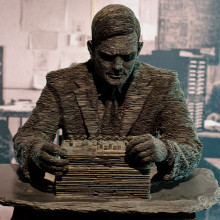This week a computer program reportedly passed the 'Turing test' for the first time, tricking people into believing it is human. This was part of a competition run by Reading University to commemorate the 60th anniversary of death of the test's creator: Alan Turing. Here is your Quick Fire Science on the Turing test...
In this episode

00:00 - The Turing Test
The Turing Test
This week a computer program reportedly passed the 'Turing test' for the first time, tricking people into believing it is human. This was part of a competition run by Reading University to commemorate the 60th anniversary of death of the test's creator: Alan Turing. Here is your Quick Fire Science on the Turing test...
- In 1950, Alan Turing developed a way to test a machine's ability to mimic human behaviour. He called this 'The Turing Test.'
- In the test, a human judge writes to a subject in another room. This subject can be a person or a machine.
- The aim of the test is for the judge to suss out whether the subject is human or machine, whilst the computer tries to dupe the judge into thinking it's a real person.
- When creating this test, Turing made a prediction. He thought by the year 2000, machines would be able to fool 30% of human judges in a five minute test.
- However by 1966, a programme called ELIZA appeared to pass the test. It used keywords from the judge's typed comments and transformed them into new sentences by following a series of rules.
- Versions of ELIZA, now known as chatterbots, are found on the internet today and they continue to trick people into believing they are human in the hope of gaining sensitive personal data.
- The latest computer program to have met Turing's predictions is called Eugene Goostman.
- The Russian-developed software emulated a thirteen year old Ukrainian boy who didn't speak much English and spoke to judges, via webchat, for 5 minutes.
- Eugene managed to fool 10 out of 30 human judges, fulfilling Turing's prediction.
- Turing never actually specified the percentage of judges that needed to be fooled for a computer to pass so it is debatable whether programs can ever be said to have passed the test.
- Some have argued that Turing's test was proposed as more of a philosophical question about a computer's abilities to mimic humans than an accurate test for artificial intelligence.
- If you want to try your luck against Eugene you can visit www.princetonai.com/bot
- Previous Why do we yawn?
- Next Pyridine: Chemistry in its element










Comments
Add a comment